Running a business means keeping an eye on your money. You should know what’s coming in, what’s going out, and what is around the corner. That is where Cash Flow Forecasting solutions come in. They help you see your future cash position clearly, so you are not caught off guard by surprise expenses or slow months.
It is ideal if you are managing a startup, a small business, or a large company; having the right forecasting tool can help you a lot. In this blog, we will look into the top 10 Cash Flow Forecasting tools in 2025. We will look into what they offer, how they offer, how they work, and how to choose the best one for your business.
What is Cash Flow Forecasting?
Cash flow forecasting is the process of estimating how much money your business will have in the future. It helps you show where the cash will come in and go out. This will help you plan, avoid shortfalls, and make smarter decisions.
It is like checking the weather before a trip. If you know it might rain (or, in this case, money might run low), you can pack an umbrella, or plan better financially.
There are two types of forecasts:
- Short-term forecasting: It is for the next few weeks or months and helps with day-to-day planning.
- Long-term forecasting: It is for looking ahead for over 6 months to a year or even more and is basically for big-picture strategy.
By choosing the right Cash Flow Forecasting tools, this process becomes quick, automatic, and far more accurate than doing it all in Excel.
Why Businesses Need Cash Flow Forecasting Tools
There is no real point in operating your business and having no clue as to what your cash flow will amount to in the future in terms of funds available- driving with one eye covered, you may get away with it a few times, but further on, there is going to be a wall.
That’s where cash flow forecasting tools come in. They allow you to forecast your revenues and costs in the long run to always give you an idea as to whether you can meet payrolls, rent, payments to suppliers, or a more ambitious expansion scheme.
Here is why they are important:
- Prevent cash crunch: You will see the periods when your cash position is likely to reach some critical level, and act in time.
- Make better decisions: Planning to launch a product or grow? The forecasts enable you to view whether you can afford it.
- Win over the investors: A clear display of the financial forecasts is one that will display to the investors that you are in control of your finances and hence instill the confidence of the investors.
- Save time: Calculations and reports are automated in these tools, and you no longer have to work with spreadsheets.
- Change to match the market: In the presence of rapidly changing conditions in the marketplace, it will take you minutes, but not weeks, to adjust your forecast to meet the changing conditions.
Key Features to Look For in a Forecasting Tool
Not all cash flow forecasting tools are made equal. If you are choosing the one for your business, you should look for the following features:
- Real-time Tracking: An effective tool will keep your cash flow up-to-date, such that it is synchronised with your bank account and the accounting program. This will make certain that you are always working on the best possible data.
- Customisable Forecasts: Each company is unique. Find a tool that will allow you to create your scenarios (monthly, weekly, daily) around your trend of earning and spending.
- Scenario Planning: Curious to know what a doubling of sales will do in the next quarter or what a late payment will do to a client? The scenario planning facility enables you to perceive various eventualities in the form of what-ifs to plan.
- Integrations with Other Tools: Your cash flow tool has to be friendly with QuickBooks or Xero or Excel, or whatever you use. This limits data entry by workers and results in manual mistakes.
- Dashboards and Reports: You can have better visual representations to help fix the financial picture quickly, together with the reports presented in a manner that they are easily understood by you, the team, or the investors.
- Alerts and Reminders: Lots of tools will give automated reminders of future bills, low balances, or significant shifts in forecasted trends. It is similar to having a personal financial assistant.
Top 10+ Best Cash Flow Forecasting Tools in 2025
Given below are the top 10+ Best Cash Flow forecasting tools in 2025, along with their overview, key features, and other important details that you need to know before choosing the right tool:
1. Vena
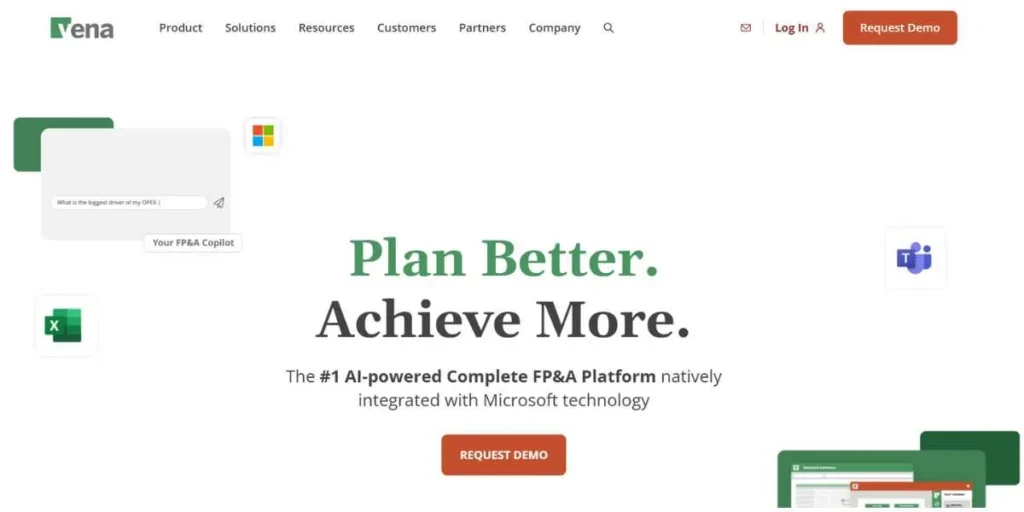
Vena is a potent financial forecasting software aimed at finance departments looking to take their planning to the next level without changing the model of what they are already good at doing — using Excel. It maintains the sense of usability of the familiar spreadsheet, adding centralised control, data security and in-built forecasting capabilities to the equation. Vena supports collaborative, accurate, and dynamic development of financial plans with intuitive workflows and powerful capabilities such as real-time data visualisations, dynamic scenario modelling, and more.
Ideal user: Mid-to-large finance teams who want more control, larger scale and automated over their reliance on Excel.
Key features:
- Excel-Friendly interface: Vena can be easily accessed by financial professionals as it is a built-in Excel system that can offer extensive automation and control of data.
- Scenario Modelling: Develop several financial models to understand how various decisions or developments can affect your cash flow.
- Real-Time Visuals: See main financial factors as they happen, and make forecasts when new information pours in.
Pricing (Free/Paid): Contact the pricing for details.
Website: https://www.venasolutions.com/
2. Datarails
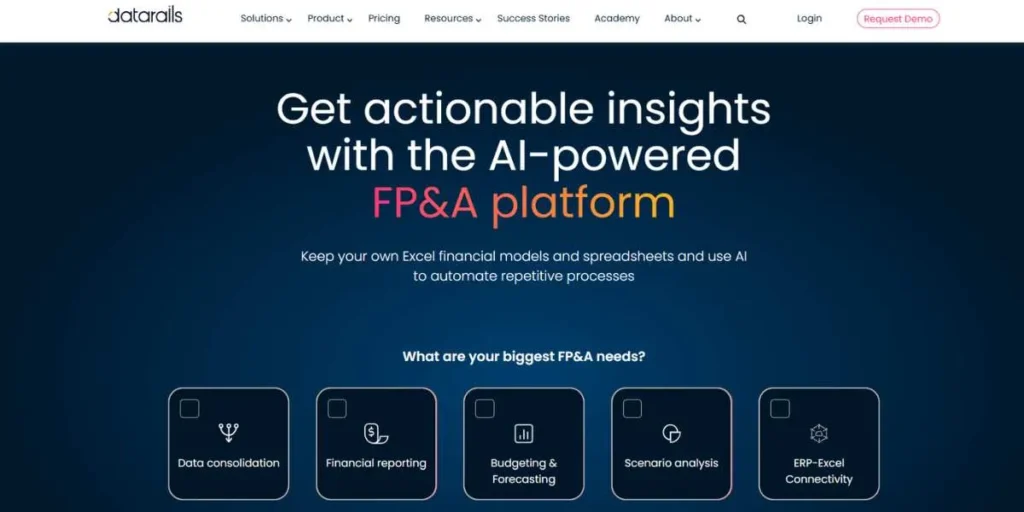
Another cutting-edge tool is Datarails; it puts automation, accuracy, and intelligent forecasting into the finance team. Designed in the cloud, it is able to connect to ERPs, CRMs and even your bank data to provide a 360 view of your cash position. The platform helps to make scenario modelling simple, reportautomaticallyc and the data centralised all as a way of making sure that leaders of finance can deal with strategy and not with manual spreadsheets.
Ideal user: CFOs, financial controllers and teams that require high-level forecasts and not too much complexity in collaboration.
Key features:
- Centralised Database: Collects financial information on various systems to provide a single point of truth.
- What-If Scenarios: Create simulations of various ways a business can work out to be ready in the best and worst situations regarding cash flow.
- Automated Reporting: Auto-correct any human error and save time using well-formatted and ready-made reports.
Pricing (Free/Paid): Contact for pricing
Website: https://www.datarails.com/
3. Workday Adaptive Planning
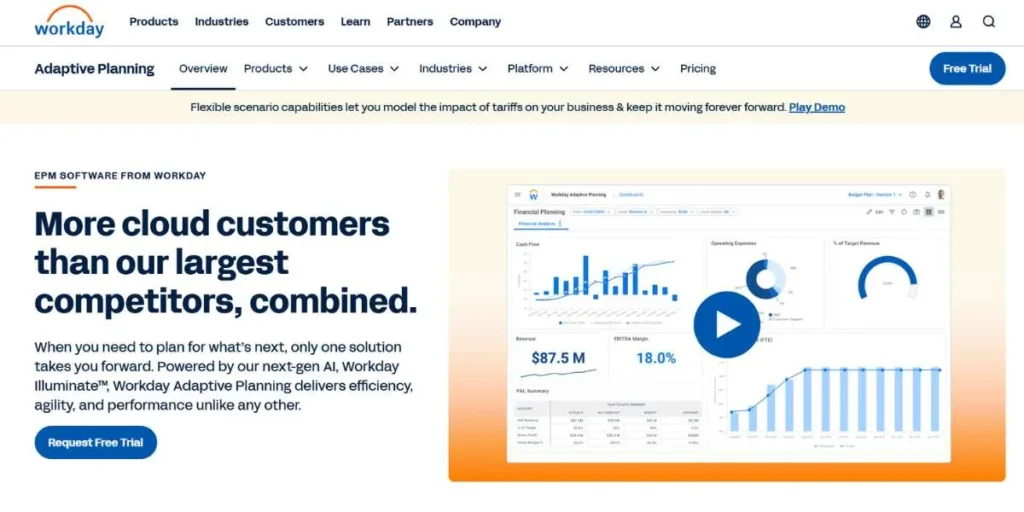
Workday Adaptive Planning is one of the most developed templates for cash flow predictions nowadays. It provides up-to-date financial visualisation and strong forecasting abilities that enable businesses to have an accurate and dynamic financial plan. As one of the leading cash flow analysis tools, it also allows teams to check the health of cash flow and plan various contingencies in other departments. The reporting services with their intuitive dashboard allow quick financial decisions and interpretation of the trends.
Ideal user: Real-time visualisation & scenario modelling
Key features:
- Workflow Management: Transforms cross-department and financial traceability.
- Scenario Modelling: Helps one to analyse various anticipated results of cash flow.
- Real-Time Financial Visualisation: Offers real-time financial information to conduct agile decision-making.
Pricing (Free/Paid): Free for 30 days, then custom pricing.
Website: https://www.workday.com
4. Planful
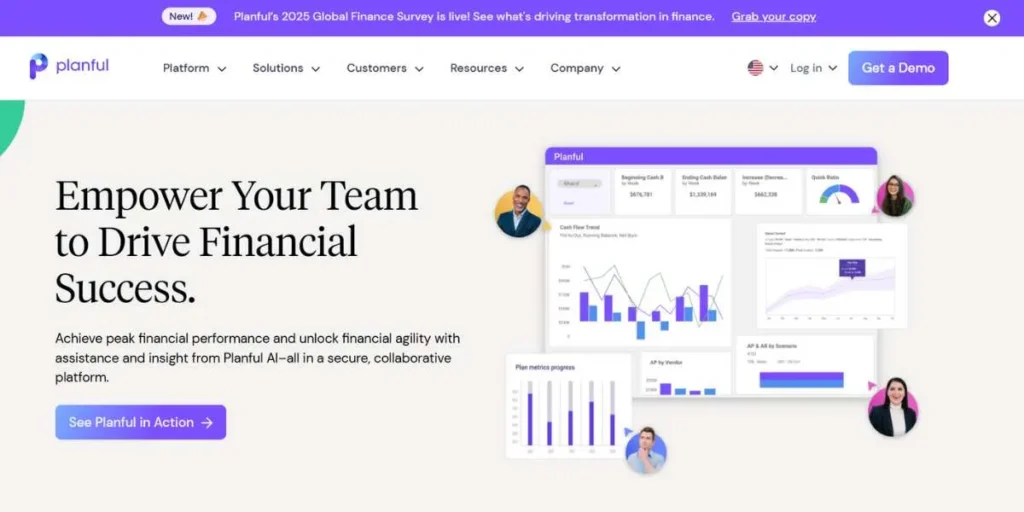
Planful provides a non-restrictive and team-working cash flow management tool, which lets companies not only track cash in and cash out, but also simulate future settings, and vicariously track financial KPIs as they happen. The platform would facilitate partnerships among projects by preventing financial planning only within one team and making data-based decisions in a short period. Using its customizable dashboards and on-demand analytics, it offers the insight required in complicated financial setups.
Ideal user: Enterprise-level collaboration and KPI tracking
Key features:
- Collaboration Tools: Enables group work planning and easy sharing of data.
- Real-Time Reporting: immediate access to financial flows, financial refresh.
- Cash Flow Forecasting: Forecasting of cash position based on the history of previous cash and trends.
Pricing (Free/Paid): Available on request.
Website: https://planful.com/
5. Prophix

Prophix makes it possible to achieve precise and sensible cash flow forecasting through artificial intelligence. As one of the more advanced budgeting and forecasting tools, it can be used to implement data-driven decision-making on its platform, to assist finance teams in working with working capital, model forecasts, and respond to current changes in business in real-time. It has a user-friendly interface, so it is easy to create forecast models, and its AI can be used to add precision through analysing historical data. Prophix improves the level of visibility and control that expanding companies need to become financially strong.
Ideal user: Mid-to-large companies needing intelligent, automated forecasting tools.
Key features:
- AI-Powered Insights: Notifies the trends of cash flow based on machine learning algorithms.
- Workflow Management: Simplifies the delivery of information and tasks of finance groups.
- Scenario Modelling: Tests several financial scenarios, in case of best- and worst-case scenarios of cash flow.
Pricing (Free/Paid): Contact vendor.
Website: https://www.prophix.com/
6. Float
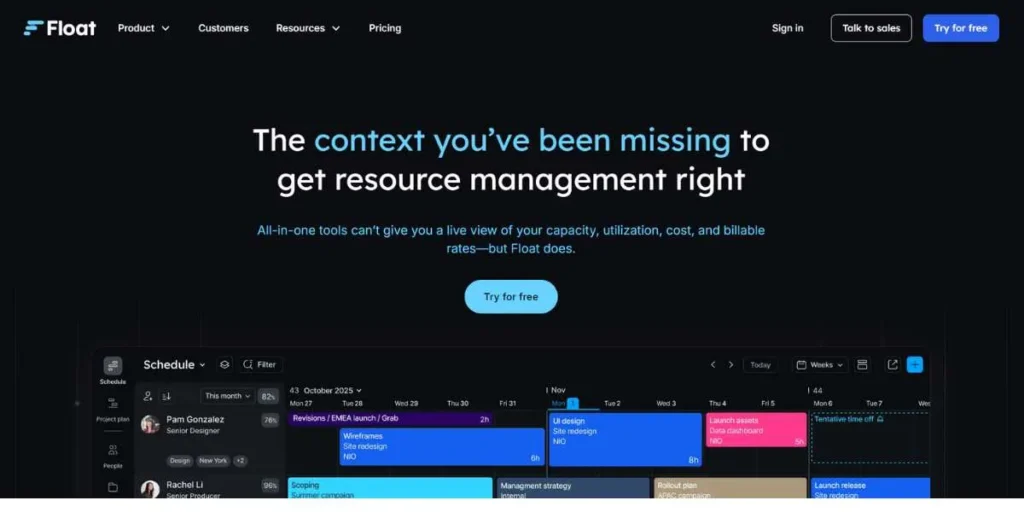
Float is a cash flow forecasting application with user-friendly features designed specifically to suit business owners (particularly those of small businesses) and freelancers. It can be easily integrated with the market-leading accounting software such as Xero and QuickBooks, making it fully automated in terms of real-time cash flow forecasts. The main distinguishing feature of Float is the presence of a visual dashboard and scenario simulator, which enables companies to receive a picture of their financial road going forward.
Ideal user: Freelancers and small business owners.
Key features:
- Automated Forecasting: Automatic forecasts and associated manual inputs are minimal with the help of the forecasting software, integrating with accounting software for accurate forecasts.
- Smart Budgeting Tools: The tool allows creating and managing smart budgets in an intuitive way to enhance the general financial performance.
- Scenario Planning: Try various financial scenarios and be ready in the case of worst-case and best-case scenarios.
Pricing (Free/Paid): 14-day free trial, contact for paid plans.
Website: https://www.float.com/
7. QuickBooks Cash Flow Planner
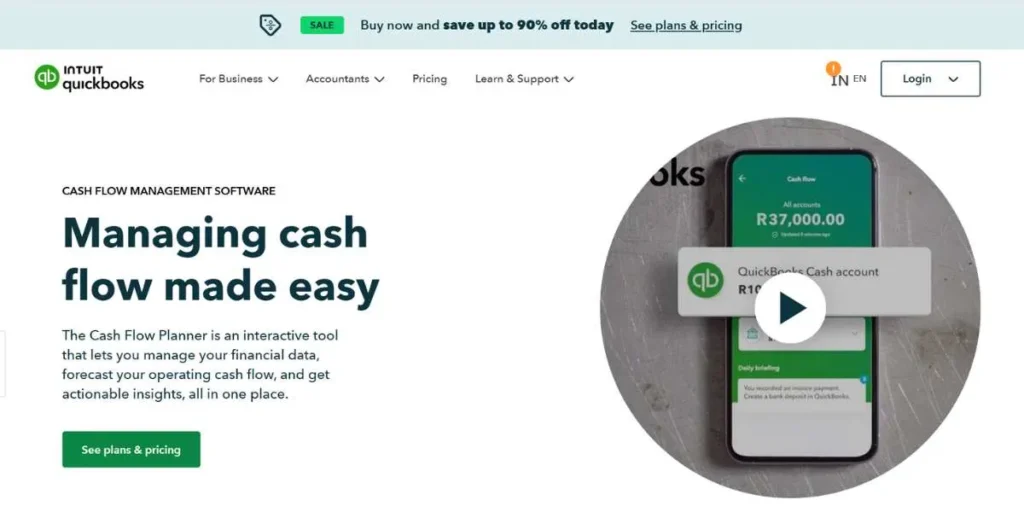
QuickBooks is already an operating system; its Cash Flow Planner is an offered option that can be considered a strong and convenient tool. It provides in-depth real-time cash flow analysis, tracking what is going on in your QuickBooks account. The ability to manage both the current and anticipated financial demands through automatic syncing and customizable reporting means reduces the number of platforms a business owner requires, allowing him or her to manage the finances more effectively.
Ideal user: Small businesses that already use QuickBooks for accounting.
Key features:
- Real-Time Cash Flow Visibility: Allows you to see your cash position in real-time to prevent shortages.
- Auto Data Syncing: Auto pulls financial data directly into QuickBooks so that forecasts remain correct all the time.
- Custom Reports: Provides flexibility to design custom cash flow reports to reflect business priorities.
Pricing (Free/Paid): Simple Start – $17.50 per month
Website: https://quickbooks.intuit.com
8. Pulse
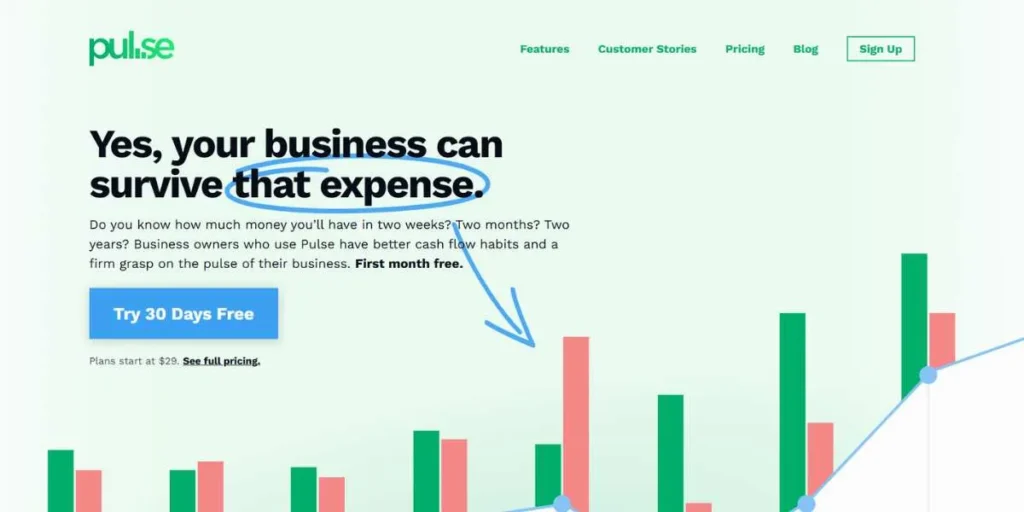
Pulse is an efficient application meant to be utilised by small to medium-sized businesses seeking to handle the cash flow but not get lost in excessive details. As one of the practical cash flow forecasting tools, it includes the complete package of forecasting capabilities, flexible budgeting and sales forecasting, scenario modelling and professional financial reporting. Pulse organises the finances of your business and makes it transparent.
Ideal user: Small and medium-sized businesses.
Key features:
- Detailed Cash Tracking: Tracks incoming and outgoing cash to have a real-time pulse of finances.
- Forecasting & Budgeting: Assists the business owners in planning for the future with flexible forecasts and budget controls.
- Wise Reporting: Produces reports that can explain the health of finances and steer superior decisions.
Pricing (Free/Paid): Starts at $59/month
Website: https://www.pulseapp.com/
9. CashAnalytics
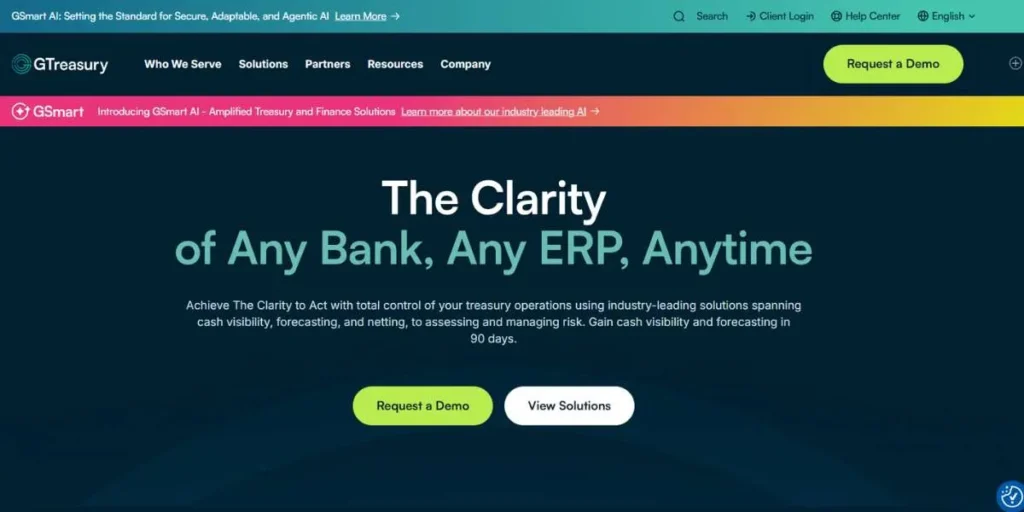
CashAnalytics may become your stress-saving cash flow forecasting system in case you are a large business with a complex asset base hard to manage in terms of financial planning. This software is specifically made to plan liquidity and offer corporate cash visibility, ty and it gathers together financial information across your organisation and gives you accurate, detailed and prompt actionable details.. CashAnalytics facilitates group-level streamlining of cash flow reporting, which is its core distinction.
Ideal user: Large organisations with diversified financial structures.
Key features:
- Liquidity Planning: Assisting you in estimating the cash available and determining whether your business will have the ability to cover your future financial demands.
- Data Consolidation: Pulls data on the cash flow in various departments and presents them in a single dashboard.
- Forecast Accuracy Tracking: Monitors how far the past forecasts have been reliable to make better planning in the future.
Pricing (Free/Paid): Custom pricing.
Website: https://www.gtreasury.com/
10. Dryrun
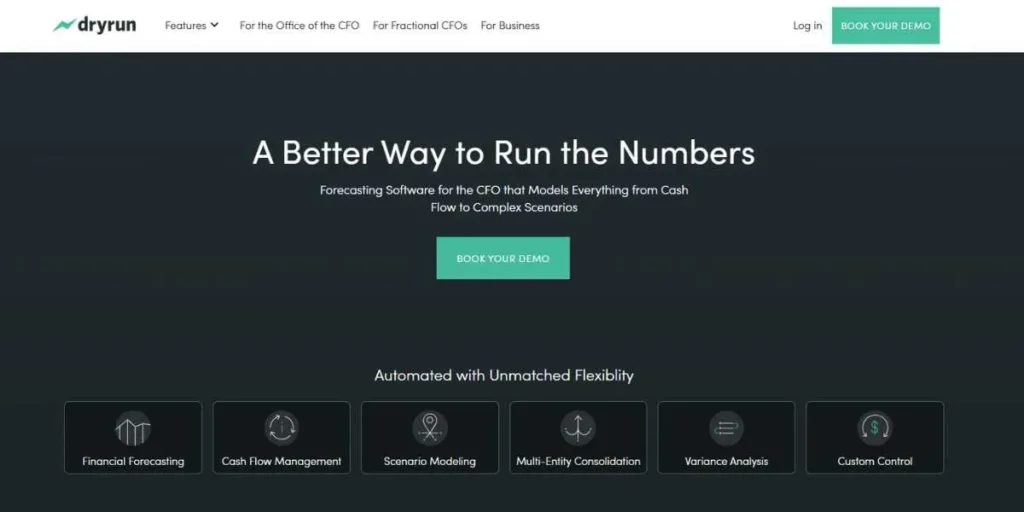
Dry run is ideal when you prefer to be flexible, collaborative, and use visual financial tools. It can be considered a potent spreadsheet on steroids, and it is perfect to be use by consultants and financial advisors who require simulating various financial options fquickly It has the best attribute ever called scenario planning that lets you experiment with the possible scenarios of changes across revenue, expenses, and investments to determine how it could affect your cash flow.
Ideal user: Financial consultants and advisors
Key features:
- Visual Forecasting: It is easy to draw a picture of the cash flows with the visual aids provided.
- Scenario Planning: Model simulation of various financial performances to make informed decisions.
- Work with teammates: Post forecast and collaborate with teammates in real time.
Pricing (Free/Paid): Contact for pricing.
Website: https://www.dryrun.com/
Comparison Table
| Top 10 Cash flow forecasting tools of 2025 | ||||
|---|---|---|---|---|
| Tool | Free Trial | Integration | Best for | Forecasting type |
| Vena | No | Excel-based, supports integrations via connectors | Mid-to-large finance teams using Excel | Scenario modelling, real-time visualisations |
| Datarails | No | ERPs, CRMs, bank data | CFOs, controllers need automated forecasting | What-if scenarios, automated reports |
| Workday adaptive planning | 30 Days free | ERP, HR, CRM systems | Real-time scenario modelling and visualisation | Real-time visual forecasting & modelling |
| Planful | No | ERP, CRM, financial tools | Enterprises needing KPI tracking & collaboration | Real-time forecasting, KPI tracking |
| Prophix | No | Multiple ERP & financial systems | Mid-large businesses needing AI-backed insights | AI-powered scenario modelling |
| Float | 14-day free trial | Xero, QuickBooks, FreeAgent | Freelancers and small business owners | Automated cash flow forecasting |
| QuickBooks Cash Flow Planner | No | Native to QuickBooks | Small businesses using QuickBooks | Real-time cash flow analysis |
| Pulse | No (Demo available) | Manual entry, CSV, limited integrations | Small and medium-sized businesses | Flexible budgeting & forecasting |
| CashAnalytics | No | Enterprise financial systems | Large corporations with complex assets | Liquidity & consolidated cash forecasting |
| Dryrun | No | QuickBooks, Xero, CSV | Financial consultants and advisors | Visual & collaborative scenario modelling |
Cash Flow Forecasting for Small Businesses vs Enterprises
Small businesses and giant businesses alike require cash flow forecasting; the process, instruments, and sophistication of the two are different.
Small businesses tend to have less cushion, a strain on their budgets and have fewer financial skills at their disposal. They can be short-term in their projections or analyse only daily (or week-to-week) cash requirements such as payroll, rent, inventory or the expense of paying vendors. It needs to be simple and quick to use, which is why small companies tend to use either spreadsheets or bottom-end forecasting tools, such as Float or Pulse. These tools assist in handling the simplest incoming and outgoing flows, and at the same time provide sufficient transparency to avoid cash crunches.
Businesses, on the other hand, contend with complicated financial environments: numerous divisions, international activity, and more capital flow. They should be in a position to foresee the long-term planning, treasury activities, and liquidity. Such tools as CashAnalytics, Anaplan, and Planful are applied here. They are connected to ERP systems, provide consolidation (of financial data) of subsidiaries and allow scenario modellingingBusinesses do not simply say Do we have sufficient levels to cover the bills, but they also desire to optimise working capital, finance risk-mitigation and fuel the strategic process using high-quality cash visibility.
How to Choose the Right Tool for Your Business
When selecting a cash flow forecasting tool, it is not only based on the slick, shiny possibilities it can offer, but finding one that is suitable for the size of your business, what your business requires and what would suit the ambitions of your financial goals.
Begin with an assessment of the extent and sophistication of your operations. And in the case you are a small business and have fairly simple income/expenses, a simple and easy-to-use app such as Float or Pulse will serve you best in keeping you on top of fulfilling short-term cash requirements, without making you crazy. They are designed to be clear and easy to control. They do not have a learning curve, and they are not costly to use.
What you want to do, though, especially if you run a medium-sized business or enterprise, is to seek out software capable of linking with your current accounting systems, multi-scenario simulations, and supporting software that is capable of operating with many entities or working on multiple currencies. Such advanced tools as Planful, CashAnalytics, or Anaplan are beneficial to be used by the more proficient users who require comprehensive forecasting, automation, and real-time knowledge.
Other aspects to consider:
- User-friendliness: How easy or difficult is the dashboard to use? Will your staff have to be trained?
- Automation: Is it able to automatically extract data in your accounting software?
- Customisation: Can it enable you to customise cash flow reporting to your pattern?
- Support and scalability: Will it also support your business growth as you grow?
Not only will the right cash flow forecasting tools provide you with peace, but also make your financial decisions better and more confident.
Conclusion
The lifeline of any business, big or small, is managing the cash flow. The appropriate cash flow forecasting tool allows you to make better financial decisions, prevent cash shortages, and gives you the power to plan with entrepreneurship. No matter what you need, it’s a startup that wants to get more viewers or an enterprise that needs to organise its work across countries, there is an option that will fit your needs. The trick will be to find out what best suits your particular structure, objectives and budget. Never has it been easier to invest in or purchase a forecasting tool and start driving your financial visibility and business profits.
In this blog, we have added the top 10 cash flow forecasting tools for business. Make an informed choice, and let your business be easy to deal with.
FAQ
What are cash flow forecasting tools?
A cash flow forecasting tool is used to guide companies on their future cash inflows and outflows. This comes in handy in budgeting, shortfall avoidance and planning of investments or expansions.
What is the importance of cash flow forecasting software to businesses?
It can offer financial visibility, better decision-making, and is a way to avoid surprises. Especially in this day and age of the erratic business world, it is very important.
Is it a tool that small businesses can use?
Yes. Numerous tools, such as Float, Pulse, and Dryrun, are tailored to businesses of small and mid-sized categories as they are easy-to-use and have cheap rates.
Are these tools compatible with my accounting program?
The majority of contemporary forecasting software products will sync up effortlessly with the likes of QuickBooks, Xero, and FreshBooks.
